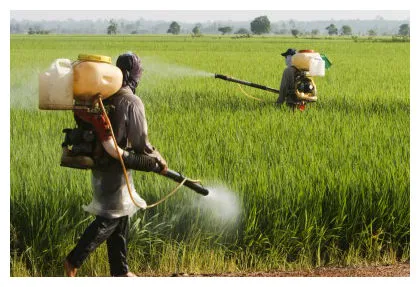By Sayer Ji
September 12, 2012
Whether
you are aware of it or not, your food, air and water are the battle ground upon
which a titanic struggle between the multinational biotech corporations
Monsanto and Dow AgroScience is now playing out. As a result, your health and
environment (and that of all future generations) are at profound risk of
irreparable harm.
Dow
AgroSciences (a subsidiary of Dow Chemicals) recently announced their development of
genetically-engineered corn, soybean, and cotton plants metabolically resistant
to the herbicide 2,4-Dichlorophenoxyacetic acid (2,4-D), a major ingredient in
Agent Orange.
What
this means for our future is that, if approved for use, vast regions of our
country will soon be sprayed with a chemical that has been linked to over 400,000 birth defects in
Vietnam.
HOW DID WE END UP HERE?
History
is repeating itself before our eyes.
Dow
Chemicals and Monsanto, joined at the karmic hip, both manufactured Agent
Orange for use in Vietnam, and both are notorious for minimizing the adverse
health effects associated with exposure to the agent.
Neither
corporation learned from its mistakes, largely because the US government
underwrote the risk of using the chemical, and therefore shielded them from the
bulk of the legal and financial fallout.
But
this lack of culpability has now set up the conditions for a reliving of the
horrors of systemic herbicide exposure, only this time on American soil, with
Monsanto choosing glyphosate (also a birth-defect causing
chemical), and Dow Chemical sticking with its old time favorite.
.
.
The two corporations are now pitched in a heated battle for dominance, as Monsanto's once global hegemony over genetically engineered staple crops like soy and corn began to falter, in the following four ways:
1)
Roundup resistance, which was bioengineered into food crops, began spreading to a number of other plants (weeds), rendering Roundup ineffective, or requiring much higher (and therefore much more toxic) quantities.
2)
Insects began to develop resistance to Monsanto's Bt gene, which was engineered into their plants as a "natural" insecticide, conferring theoretical resistance to Bt-sensitive pests.
3)
Research on glyphosate, the major active ingredient in Roundup, which has been used at the rate of 80,000 tons in the US in 2007 alone, began to accumulate, linking it to dozens of serious adverse health.
4)
Glyphosate was found to contaminate our air, food and groundwater.
Given
these fatal flaws in Monsanto's once impenetrable armor, Dow AgroScience is
positioning its new GE plants as a "next-generation" solution to the
problems of glyphosate and Bt resistance.
However, by engineering what amounts to Agent Orange-resistance into their "new and improved" crops the potential environmental and health fallout to exposed areas is nothing less than horrific.
Do
we need to view pictures of the victims of Agent Orange to be reminded of how
toxic the ingredients in this herbicide are? (Warning: the images are
graphic).
.
.
Instead of learning from Monsanto's colossal mistakes (which happens when you play geneticist-as-God and use a broad spectrum poison to kill all but your "chosen" plants) Dow AgroScience's solution is to multiply the problem by a factor of three, creating the "first-ever, three-gene," herbicide-tolerant staple crops.
What
this means is that instead of using only one highly toxic herbicide (Roundup), THREE
will be used simultaneously, further increasing the risk of serious exposures,
and setting up the conditions for synergistic toxicities ~something that
toxicological risk assessments on singular herbicide ingredients, which
establish "an acceptable level of harm," never account for.
While
Dow AgroScience claims that 2,4 D resistance will not present the same problem
that Roundup resistance did for Monsanto, the science to support these
marketing claims is not on their side.
.
.
In a recent article published in the Proceedings of the National Academy of Sciences of the United States, researchers reviewed Dow Chemicals' own published research on 2,4 D resistant crops, and found it highly misleading and inaccurate.
They
noted:
In their recent article, we feel that Wright et al. (1) [Dow AgroSciences researcher] misrepresented the potential for 2,4-dichlorophenoxyacetic acid (2,4-D)–resistant weeds in 2,4-D–resistant cropping systems and exaggerated the sustainability of their approach to addressing glyphosate-resistant weed problems in agriculture.
They
also noted:
We were surprised that Wright et al. (1) stated that only "very few" 2,4-D–resistant weed species have evolved without quoting a specific number. We checked the database that they used to support this claim (2) and were alarmed to learn that, globally, 28 species across 16 plant families have already evolved resistance to the synthetic auxin herbicides, the mode of action to which 2,4-D belongs.Of these, 16 are known to be resistant to 2,4-D specifically (for comparison, 21 species are resistant to glyphosate globally). Furthermore, the claim that 2,4-D resistance is unlikely to evolve because of the complex and essential functions that auxin plays in plants is unsubstantiated.
In
a nutshell, 2,4 D and 2,4 D resistant crops are not a solution to the
underlying problem of herbicide resistance in genetically engineered crops. In
the same way that we have created the monster of antibiotic-resistance
super-bugs like MRSA (methillicin-resistant staphylococcus aureus), continually
developing more and more toxic chemicals to combat a problem that cannot be
solved with them,
Nature will ultimately survive
the manmade systems
that seek to dominate her modes of
production;
the question is
whether we will survive ourselves,
if we continue down this path much
longer.
Sayer
Ji is the founder and director of GreenMedInfo.com and co-author of the book The Cancer Killers: The Cause Is The
Cure
with New York Times
best-seller Dr. Ben Lerner and Dr. Charles Majors. His writings and research
have been published in the Wellbeing Journal, the Journal of Gluten
Sensitivity, and have been featured on Mercola.com, NaturalNews.com,
Reuters.com, GaryNull.com, and Care2.com. Check out his newest project: Dr. Gourmet.
DOW AND MONSANTO JOIN FORCES TO POISON AMERICA'S HEARTLAND
DOW AND MONSANTO JOIN FORCES TO POISON AMERICA'S HEARTLAND





No comments:
Post a Comment
If your comment is not posted, it was deemed offensive.